Cast * Story * Interesting Facts * Production Details * Interview
Cast * Story * Interesting Facts * Production Details * Interview
Directed by: John Musker & Ron Clements
Written by: Barry Johnson (story supervisor) & Robert Louis
Stevenson (novel)
Music by: James Newton Howard (score) & John Rzeznik (songs)
Budget: $140 million (unconfirmed) plus $40 million in marketing
costs
Production Start Date: June 1999, principal animation started
on November 6, 2000
Release Date: November 27, 2002
Running Time: 95 minutes
Box Office: $38.12 million in the U.S., $92 million worldwide
 |
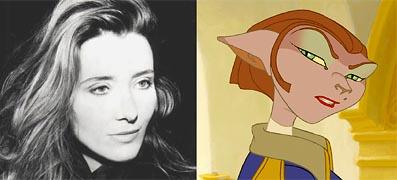 |
 |
 |
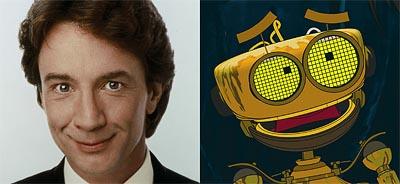 |
Jim Hawkins... Joseph Gordon-Levitt (speaking), Johnny Rzeznik
(reported singing voice)
John Silver... Brian Murray (the role was originally offered
to Sean Connery, then Jack Palance)
Captain Amelia... Emma Thompson
Dr. Doppler... David Hyde Pierce
B.E.N. (Bio Electronic Navigator)... Martin Short
Skroopf... Michael Wincott
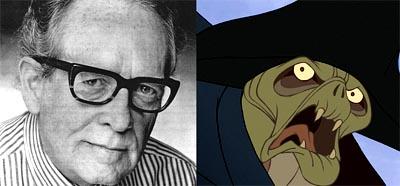 |
 |
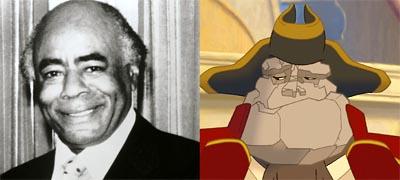 |
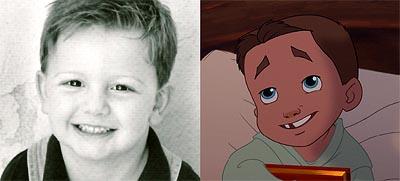 |
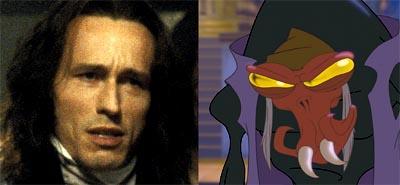 |
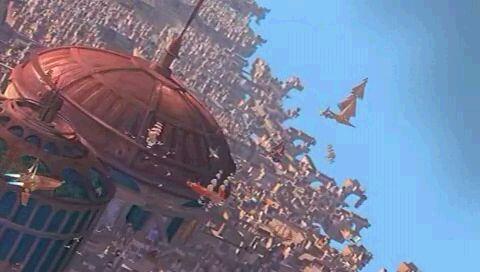 A
futuristic twist on Robert Louis Stevenson's "Treasure Island," Treasure
Planet follows restless teen Jim Hawkins on a fantastic journey across
the universe as cabin boy aboard a majestic space galleon. Befriended by
the ship's charismatic cyborg cook, John Silver, Jim blossoms under his
guidance and shows the makings of a fine shipmate as he and the alien crew
battle a supernova, a black hole, and a ferocious space storm. But even
greater dangers lie ahead when Jim discovers that his trusted friend Silver
is actually a scheming pirate with mutiny on his mind.
A
futuristic twist on Robert Louis Stevenson's "Treasure Island," Treasure
Planet follows restless teen Jim Hawkins on a fantastic journey across
the universe as cabin boy aboard a majestic space galleon. Befriended by
the ship's charismatic cyborg cook, John Silver, Jim blossoms under his
guidance and shows the makings of a fine shipmate as he and the alien crew
battle a supernova, a black hole, and a ferocious space storm. But even
greater dangers lie ahead when Jim discovers that his trusted friend Silver
is actually a scheming pirate with mutiny on his mind.
![]() For nearly
two decades, Walt Disney Co. filmmakers Ron Clements and John Musker dreamed
of making an animated movie based on Robert Louis Stevenson's classic coming-of-age
novel "Treasure Island." In their version, the action would unfold in outer
space. Even though the pair would emerge over time as two of the studio's
hottest director-producers, with such hits as The
Little Mermaid, Aladdin and Hercules,
the studio kept rejecting the pitch and shelving
the project, saying it lacked fairy-tale magic. But the two men persevered,
refusing to let their dream die at the hands of disbelievers. They even
outlasted the biggest naysayer of them all, studio Chairman Jeffrey Katzenberg,
who was fired in 1994. So with the backing of Vice Chairman Roy Disney
himself--and a special contract provision--the duo finally co-wrote, directed
and produced Treasure Planet.
For nearly
two decades, Walt Disney Co. filmmakers Ron Clements and John Musker dreamed
of making an animated movie based on Robert Louis Stevenson's classic coming-of-age
novel "Treasure Island." In their version, the action would unfold in outer
space. Even though the pair would emerge over time as two of the studio's
hottest director-producers, with such hits as The
Little Mermaid, Aladdin and Hercules,
the studio kept rejecting the pitch and shelving
the project, saying it lacked fairy-tale magic. But the two men persevered,
refusing to let their dream die at the hands of disbelievers. They even
outlasted the biggest naysayer of them all, studio Chairman Jeffrey Katzenberg,
who was fired in 1994. So with the backing of Vice Chairman Roy Disney
himself--and a special contract provision--the duo finally co-wrote, directed
and produced Treasure Planet.
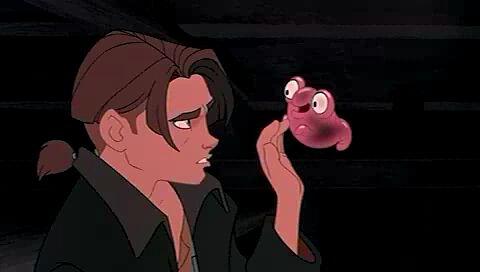
![]() Treasure Planet
is Disney's first animated feature set in space. The story of this
outer-space science fiction film is parallel to the famous "Treasure Island"
novel but with aliens, robots, and space pirates.
Treasure Planet
is Disney's first animated feature set in space. The story of this
outer-space science fiction film is parallel to the famous "Treasure Island"
novel but with aliens, robots, and space pirates.
![]() The premise behind
it, as described in 1999's Disney Convention in London, is: "What could
Disney do that hasn't been done with SFX in live action movies?" The answer
from their animation studios was "Loads". The animators will be visually
playing with some of the concepts of space and time, showing incredible
visions of alien worlds and otherworldly life.
The premise behind
it, as described in 1999's Disney Convention in London, is: "What could
Disney do that hasn't been done with SFX in live action movies?" The answer
from their animation studios was "Loads". The animators will be visually
playing with some of the concepts of space and time, showing incredible
visions of alien worlds and otherworldly life.
![]() John Musker and
Ron Clements (The Little Mermaid,
Aladdin,
Hercules)
directed the film and Glen Keane (Pocahontas,
Aladdin,
Beauty
and the Beast, Tarzan), who joined
the project in April 1999, is animating the villain, cyborg Long John Silver.
John Musker and
Ron Clements (The Little Mermaid,
Aladdin,
Hercules)
directed the film and Glen Keane (Pocahontas,
Aladdin,
Beauty
and the Beast, Tarzan), who joined
the project in April 1999, is animating the villain, cyborg Long John Silver.
![]() Ron Clements'
original concept for the film was to combine a science-fiction adventure
with traditional Disney animation. "Science fiction on film can often be
kind of cold and distancing and kind of high-tech. And for this movie to
work we really thought it had to be the opposite of all those things. It
had to be warm and inviting and really pull you into the movie. We didn't
want to have that kind of chrome feel to it. So basically we decided early
on to set this in a fantasy universe, one that was neither the past nor
the future, but this kind of alternate world. The nautical themes just
seemed to translate so easily to outer space. The ocean can become space
and the ships become spaceships and a wooden-legged pirate can become a
cyborg and his pet parrot can be turned into a shape-shifting blob of protoplasm.
And also this made it much more of a fantasy, which I think is better suited
for animation. We were propelled into that by one image that we wanted
to make work, and that was sort of the three-masted galleon sailing across
the sky with its sails kind of bursting and crackling with solar energy
and its decks open to the breezes of this sort of etherium, where the shirts
could rustle in the breeze and you would get the romance of the sea. So
we needed a world where that image would kind of work and that's the direction
we headed in. And we went to the 17th century for the aesthetic, the kind
of hand-crafted feel of that, the warmth of that. But we wanted it to be
a world where solar energy was really sort of a primary source of power,
so we kind of played it as if technology had skipped a groove there. We
got this fusion going basically, where you can have a world of holographic
treasure maps, but one where you could have brass telescopes and tea cozies."
Ron Clements'
original concept for the film was to combine a science-fiction adventure
with traditional Disney animation. "Science fiction on film can often be
kind of cold and distancing and kind of high-tech. And for this movie to
work we really thought it had to be the opposite of all those things. It
had to be warm and inviting and really pull you into the movie. We didn't
want to have that kind of chrome feel to it. So basically we decided early
on to set this in a fantasy universe, one that was neither the past nor
the future, but this kind of alternate world. The nautical themes just
seemed to translate so easily to outer space. The ocean can become space
and the ships become spaceships and a wooden-legged pirate can become a
cyborg and his pet parrot can be turned into a shape-shifting blob of protoplasm.
And also this made it much more of a fantasy, which I think is better suited
for animation. We were propelled into that by one image that we wanted
to make work, and that was sort of the three-masted galleon sailing across
the sky with its sails kind of bursting and crackling with solar energy
and its decks open to the breezes of this sort of etherium, where the shirts
could rustle in the breeze and you would get the romance of the sea. So
we needed a world where that image would kind of work and that's the direction
we headed in. And we went to the 17th century for the aesthetic, the kind
of hand-crafted feel of that, the warmth of that. But we wanted it to be
a world where solar energy was really sort of a primary source of power,
so we kind of played it as if technology had skipped a groove there. We
got this fusion going basically, where you can have a world of holographic
treasure maps, but one where you could have brass telescopes and tea cozies."
![]() Originally scheduled for Summer 2002, then officially announced for Fall
2002, Treasure Planet was later pushed back one more time to Christmas
2003 before being finally moved to an earlier Christmas 2002 release slot).
Originally scheduled for Summer 2002, then officially announced for Fall
2002, Treasure Planet was later pushed back one more time to Christmas
2003 before being finally moved to an earlier Christmas 2002 release slot).
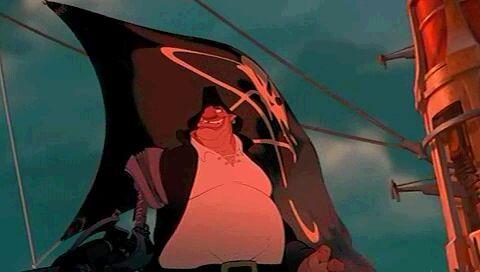
![]() Glen Keane admitted in the summer of 2000 that this is movie presents a
new challenge to him as an animator, because he is drawing only half of
the main character. The other half isCG, to be added when he is finished
animating his part. This character is a pirate, with one leg and an eye
patch. But since this movie is set in the scifi future, he does not have
a wooden leg but a robotic one (enter CG). The character will likely be
split vertically down the whole body with traditional/CG animation, instead
of horizontally at the waist. Everyone associated with the film is very
excited, saying that is is quite a depart from the Disney of the 90's.
Glen Keane admitted in the summer of 2000 that this is movie presents a
new challenge to him as an animator, because he is drawing only half of
the main character. The other half isCG, to be added when he is finished
animating his part. This character is a pirate, with one leg and an eye
patch. But since this movie is set in the scifi future, he does not have
a wooden leg but a robotic one (enter CG). The character will likely be
split vertically down the whole body with traditional/CG animation, instead
of horizontally at the waist. Everyone associated with the film is very
excited, saying that is is quite a depart from the Disney of the 90's.
![]() Continuing Disney's
move away from animated musicals (started with Toy
Story and since continued with
Tarzan
and The Emperor's New Groove),
the characters in this movie won't be singing. There will be music
though, including a song heavily featured in the film, by John Rzeznik,
lead singer of the Goo Goo Dolls -who is also rumoured to be the singing
voice of lead character Jim Hawkins. Johnny Rzeznik confirmed in March
2002 that he worked on two solo songs for Disney's Treasure Planet.
"It's basically the story of Treasure Island in space. It's really
an awesome movie, such a cool movie, man. I was like freaking out when
I saw this movie. Because I was like, 'Oh, Disney thing. It's an honor
to do this, but I don't want to be like, 'Hakuna, matata.' It's like, 'No.
No, no, no, no.'" Rzeznik worked in the Disney animation studios and was
asked to write songs there on the spot while watching the movie. Rzeznik
added that he wrote songs from the perspective of one of the film's main
characters -likely Jim Hawkins.
Continuing Disney's
move away from animated musicals (started with Toy
Story and since continued with
Tarzan
and The Emperor's New Groove),
the characters in this movie won't be singing. There will be music
though, including a song heavily featured in the film, by John Rzeznik,
lead singer of the Goo Goo Dolls -who is also rumoured to be the singing
voice of lead character Jim Hawkins. Johnny Rzeznik confirmed in March
2002 that he worked on two solo songs for Disney's Treasure Planet.
"It's basically the story of Treasure Island in space. It's really
an awesome movie, such a cool movie, man. I was like freaking out when
I saw this movie. Because I was like, 'Oh, Disney thing. It's an honor
to do this, but I don't want to be like, 'Hakuna, matata.' It's like, 'No.
No, no, no, no.'" Rzeznik worked in the Disney animation studios and was
asked to write songs there on the spot while watching the movie. Rzeznik
added that he wrote songs from the perspective of one of the film's main
characters -likely Jim Hawkins.
![]() "I saw the film
when it was pretty much just sketches with dialogue," John Rzeznik said
of writing "I'm Still Here (Jim's Theme)," which is heard during a turning
point for the film's main character. "I went home and I wrote it and, you
know, it's Disney, I figured that they would say, 'Well, nice try guy,
but we're going to go with something a little more kid-friendly,' or something.
But, lo and behold, it all worked out, which was amazing to me. I think
there's a lot of teenagers that are going to be able to relate to Jim.
He's a pretty modern kind of character, because his father bailed on the
family when he was a little kid, so he's being raised by a single mother.
And he's resentful towards his father and he displays that resentment by
going out and causing trouble and gets brought home by the cops, and then
he runs away on this big adventure to become a man. I think that's why
it was so easy to write it. There was so much in his character that I could
relate to."
"I saw the film
when it was pretty much just sketches with dialogue," John Rzeznik said
of writing "I'm Still Here (Jim's Theme)," which is heard during a turning
point for the film's main character. "I went home and I wrote it and, you
know, it's Disney, I figured that they would say, 'Well, nice try guy,
but we're going to go with something a little more kid-friendly,' or something.
But, lo and behold, it all worked out, which was amazing to me. I think
there's a lot of teenagers that are going to be able to relate to Jim.
He's a pretty modern kind of character, because his father bailed on the
family when he was a little kid, so he's being raised by a single mother.
And he's resentful towards his father and he displays that resentment by
going out and causing trouble and gets brought home by the cops, and then
he runs away on this big adventure to become a man. I think that's why
it was so easy to write it. There was so much in his character that I could
relate to."

![]() "I wrote ["Always Know Where You Are"] right at the end of when we were
finishing [the Goo Goo Dolls' latest album,] Gutterflower,'" John
Rzeznik explained. "We had to deal with some politics with Warner Bros.
They let me write it, obviously, but then they... wouldn't let me, personally,
have another song on the soundtrack, so Hollywood [Records] got BBMak to
sing it." Although a little frustrating, the singer didn't let that get
in the way of the project. "I wanted to make sure I got it into the movie,
because I thought that it fit really well, and all the guys at Disney,
they were like, 'This song totally works for the end of the movie,'" he
says. "I do it in the movie, but not on the soundtrack. It's not a big
deal."
"I wrote ["Always Know Where You Are"] right at the end of when we were
finishing [the Goo Goo Dolls' latest album,] Gutterflower,'" John
Rzeznik explained. "We had to deal with some politics with Warner Bros.
They let me write it, obviously, but then they... wouldn't let me, personally,
have another song on the soundtrack, so Hollywood [Records] got BBMak to
sing it." Although a little frustrating, the singer didn't let that get
in the way of the project. "I wanted to make sure I got it into the movie,
because I thought that it fit really well, and all the guys at Disney,
they were like, 'This song totally works for the end of the movie,'" he
says. "I do it in the movie, but not on the soundtrack. It's not a big
deal."
![]() Producer Roy Conli
explained that "interestingly, Glen Keane
came in early on with a CD [that had the song] 'Iris' on it. We were looking
at Irish bands [and] we knew we wanted a kind of Irish flavor and lilt
to this thing. There was a certain kind of Irish percussive thing that
was going on in 'Iris' that we really liked. I saw a copy of City of
Angels and saw how well that song fit in and so we called John in.
We played for him the story reel, which at that time, probably [had only]
ten minutes of animation and the rest of it [was] story. At the end of
it, he just was blown away because he totally related with Jim and he saw
where we were going with this guy. He came back about four weeks later.
He had maybe two or three lines of dialogue, and started [working out the
percussion for the song]. From that we could feel the excitement for what
the performance would be. And then a couple weeks later he came back with
the lyric. [It] was brilliant because the great thing about how John writes
for film is that he writes from a poetic standpoint instead of a narrative
standpoint. Because when you are seeing something on film, you don’t want
to just reincapsulate it by what the narrative is. You want to somehow
just reinforce it from the poetic and he’s able to do that. I think he
did that with both songs."
Producer Roy Conli
explained that "interestingly, Glen Keane
came in early on with a CD [that had the song] 'Iris' on it. We were looking
at Irish bands [and] we knew we wanted a kind of Irish flavor and lilt
to this thing. There was a certain kind of Irish percussive thing that
was going on in 'Iris' that we really liked. I saw a copy of City of
Angels and saw how well that song fit in and so we called John in.
We played for him the story reel, which at that time, probably [had only]
ten minutes of animation and the rest of it [was] story. At the end of
it, he just was blown away because he totally related with Jim and he saw
where we were going with this guy. He came back about four weeks later.
He had maybe two or three lines of dialogue, and started [working out the
percussion for the song]. From that we could feel the excitement for what
the performance would be. And then a couple weeks later he came back with
the lyric. [It] was brilliant because the great thing about how John writes
for film is that he writes from a poetic standpoint instead of a narrative
standpoint. Because when you are seeing something on film, you don’t want
to just reincapsulate it by what the narrative is. You want to somehow
just reinforce it from the poetic and he’s able to do that. I think he
did that with both songs."
![]() Treasure Planet
is
described as more elaborate in size and scope than Atlantis:
The Lost Empire. A review of an early print commented that
"overall, it was a very enjoyable film. It really had something for everybody.
If comparing to other Disney films I would liken it to Tarzan.
The animation that was complete was very well done, but not groundbreaking.
Alien characters were very interesting and imaginative. The questionnaire
passed out after the film seemed concerned about the pacing of the film
as well as the audience's enjoyment of the ending which, in my opinion
is the film's biggest weaknesses."
Treasure Planet
is
described as more elaborate in size and scope than Atlantis:
The Lost Empire. A review of an early print commented that
"overall, it was a very enjoyable film. It really had something for everybody.
If comparing to other Disney films I would liken it to Tarzan.
The animation that was complete was very well done, but not groundbreaking.
Alien characters were very interesting and imaginative. The questionnaire
passed out after the film seemed concerned about the pacing of the film
as well as the audience's enjoyment of the ending which, in my opinion
is the film's biggest weaknesses."
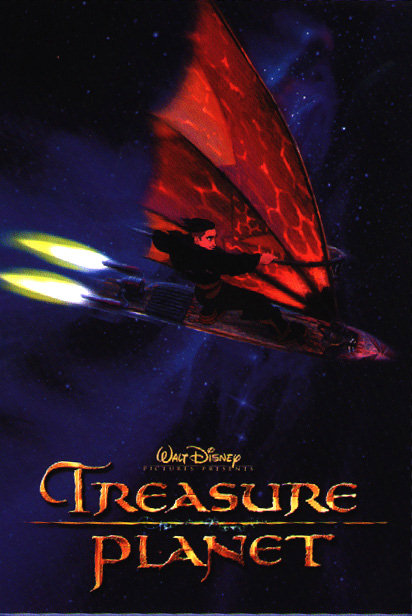
![]() Ron Musker and John Clements are looking at films like the Three Caballeros,
Alice
in Wonderland, Peter Pan and
other work done by famous art director Mary Blair for the style of their
film.
Ron Musker and John Clements are looking at films like the Three Caballeros,
Alice
in Wonderland, Peter Pan and
other work done by famous art director Mary Blair for the style of their
film.
![]() Art
from Treasure Planet was unveiled at the Disney Animation building
of Disney's California Adventure in January 2001. It shows a "cityscape
that looks ike the skyline from the Jerusalem,only completely vertical
with some H.G. Welles-looking vehicle floating in the sky", a visitor reports.
Art
from Treasure Planet was unveiled at the Disney Animation building
of Disney's California Adventure in January 2001. It shows a "cityscape
that looks ike the skyline from the Jerusalem,only completely vertical
with some H.G. Welles-looking vehicle floating in the sky", a visitor reports.
![]() Animator John
Pomeroy, who worked on Atlantis,
revealed the following while promoting the movie in June 2001: "As soon
as I finished animation on this film they came right in and scooped me
up for their next feature, Treasure Planet. It’s a science
fiction adaptation of the Robert Louis Stevenson novel. I wasn’t
assigned a particular character, they gave me a whole sequence to supervise
the animation on. It’s the opening sequence where the Treasure Cruiser
gets overtaken by the pirate Corsair. There’s a great battle then
they overtake it and loot it. So it kind of reminds you of some of
the great scenes from Captain Blood." Considering all of the research
that went into Atlantis,
where can you go to research something like this? "There are museums
that are in the Caribbean or in southern Florida or even New Orleans.
I think there’s a museum [in New Orleans] for anything that has to do with
Jean LaFete. They’ve gotten a whole lot of research. They’ve
been working on this for the last 2 ½ years. It’s the same
team that produced Hercules, Ron Clements
and John Musker. It’s the traditional pirate look with a slight science
fiction element."
Animator John
Pomeroy, who worked on Atlantis,
revealed the following while promoting the movie in June 2001: "As soon
as I finished animation on this film they came right in and scooped me
up for their next feature, Treasure Planet. It’s a science
fiction adaptation of the Robert Louis Stevenson novel. I wasn’t
assigned a particular character, they gave me a whole sequence to supervise
the animation on. It’s the opening sequence where the Treasure Cruiser
gets overtaken by the pirate Corsair. There’s a great battle then
they overtake it and loot it. So it kind of reminds you of some of
the great scenes from Captain Blood." Considering all of the research
that went into Atlantis,
where can you go to research something like this? "There are museums
that are in the Caribbean or in southern Florida or even New Orleans.
I think there’s a museum [in New Orleans] for anything that has to do with
Jean LaFete. They’ve gotten a whole lot of research. They’ve
been working on this for the last 2 ½ years. It’s the same
team that produced Hercules, Ron Clements
and John Musker. It’s the traditional pirate look with a slight science
fiction element."
![]() As producer, Roy
Conli not only collaborated with directors Ron Clements and John Musker
from script development through post production: he was also involved with
choosing the animators who would create the individual characters. "It's
very much like casting the voice in a sense," Roy explained. "There are
certain animators that you feel, 'Boy, they're going to be able to achieve
this level.' Ken Duncan, who did Captain Amelia, actually also did Skroop.
We had wanted him to do Skroop because Ken has done a whole series of women
down the line. He did Meg and he did Jane in Tarzan.
We knew that Ken wanted to stretch, so we talked to him about Skroop. He
got really excited to do this big bad villain which he did incredibly well,
but also when we got down to actually doing Captain Amelia, we felt like
we wanted Ken because we knew that Ken could do these great, strong women
characters. So, we went back to him and said, 'You know, Skroop only has
about 1,000 feet [of film]. You think you could do another character that
has 2,000?' He agreed to do it and it was great because he had two teams
that he oversaw. Both did a great job. When you have a Glen Keane at the
studio, it's pretty easy to figure out that he can do anything you want.
John Ripa, I know John and I've worked with John. John worked with me on
Hunchback
of Notre Dame and I used to drive into the parking lot and I'd
catch John behind the building acting out scenes. I knew that he's a lovely
guy and he's so angst-filled that I just knew that he would be right."
As producer, Roy
Conli not only collaborated with directors Ron Clements and John Musker
from script development through post production: he was also involved with
choosing the animators who would create the individual characters. "It's
very much like casting the voice in a sense," Roy explained. "There are
certain animators that you feel, 'Boy, they're going to be able to achieve
this level.' Ken Duncan, who did Captain Amelia, actually also did Skroop.
We had wanted him to do Skroop because Ken has done a whole series of women
down the line. He did Meg and he did Jane in Tarzan.
We knew that Ken wanted to stretch, so we talked to him about Skroop. He
got really excited to do this big bad villain which he did incredibly well,
but also when we got down to actually doing Captain Amelia, we felt like
we wanted Ken because we knew that Ken could do these great, strong women
characters. So, we went back to him and said, 'You know, Skroop only has
about 1,000 feet [of film]. You think you could do another character that
has 2,000?' He agreed to do it and it was great because he had two teams
that he oversaw. Both did a great job. When you have a Glen Keane at the
studio, it's pretty easy to figure out that he can do anything you want.
John Ripa, I know John and I've worked with John. John worked with me on
Hunchback
of Notre Dame and I used to drive into the parking lot and I'd
catch John behind the building acting out scenes. I knew that he's a lovely
guy and he's so angst-filled that I just knew that he would be right."

![]() A first trailer
leaked online available in July 2001.
A first trailer
leaked online available in July 2001.
![]() The Orlando Weekly
announced in December 2001 that Michael Eisner "ordered that new scenes
be put into production [for Treasure Planet] and new dialogue be
recorded to lighten up the pivotal character" Jim Hawkins. "That epic,
animated adventure has been in production for more than four years now.
But only after viewing the nearly completed cartoon this past October did
Disney CEO Michael Eisner realize how dark and dour portions of the project
had become. Eisner reportedly had big problems with the portrayal of one
of the characters, Jim Hawkins, carried over from Stevenson's original
novel. According to those who are now saddled with reworking the project
at the last minute, Eisner found the animated version of Hawkins to be
'too mopey'. Stranger still, Eisner has insisted that the number of swords
featured in the film be significantly reduced. And pirates -- whether
they work in outer space or not -typically carry swords. But in this post-September
11 era, when even a box cutter can be viewed as a dangerous weapon, characters
brandishing cutlasses in what is supposed to be a fun family film don't
seem all that funny anymore. Which is why numerous Disney animators in
Burbank spent most of December frantically reworking various scenes for
Treasure
Planet, removing every sword they could find."
The Orlando Weekly
announced in December 2001 that Michael Eisner "ordered that new scenes
be put into production [for Treasure Planet] and new dialogue be
recorded to lighten up the pivotal character" Jim Hawkins. "That epic,
animated adventure has been in production for more than four years now.
But only after viewing the nearly completed cartoon this past October did
Disney CEO Michael Eisner realize how dark and dour portions of the project
had become. Eisner reportedly had big problems with the portrayal of one
of the characters, Jim Hawkins, carried over from Stevenson's original
novel. According to those who are now saddled with reworking the project
at the last minute, Eisner found the animated version of Hawkins to be
'too mopey'. Stranger still, Eisner has insisted that the number of swords
featured in the film be significantly reduced. And pirates -- whether
they work in outer space or not -typically carry swords. But in this post-September
11 era, when even a box cutter can be viewed as a dangerous weapon, characters
brandishing cutlasses in what is supposed to be a fun family film don't
seem all that funny anymore. Which is why numerous Disney animators in
Burbank spent most of December frantically reworking various scenes for
Treasure
Planet, removing every sword they could find."
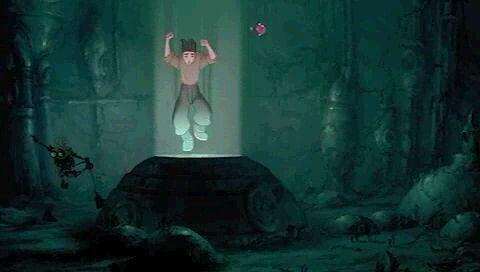
![]() Richard Cook, chairman of The Walt Disney Motion Pictures Group, announced
on January 24, 2002 that Treasure Planet would be released simultaneously
in 35mm venues as well as in IMAX Theatres and other large format cinemas
on November 27th. It will become the first major Studio feature specifically
formatted for the Giant Screen to receive a day-and-date release. Commenting
on the announcement, Cook said, "Fantasia
2000 was an enormous success in IMAX and the initial returns for
Beauty
and the Beast in IMAX and other Giant Screen venues further demonstrate
that audiences love the experience of seeing our animated films in this
large format. Treasure Planet is a daring and exciting fantasy that
uses the Giant Screen to best advantage and lets moviegoers immerse themselves
in the story. This is a great way to see this imaginative film and provides
a whole new option for seeing the film in its first run." Thomas Schumacher,
president of Walt Disney Feature Animation, added, "Whether audiences choose
to see 'Treasure Planet' on the Giant Screen or in a traditional 35mm theater,
they're in for a spectacular experience. Not only is it an action-filled
adventure with characters that moviegoers will genuinely care about, but
it pushes the art of animation into new directions. John Musker and Ron
Clements have an incredible track record as directors and, with this film,
they explore new areas of the storytelling arena." Don Hahn, the producer
of such Disney blockbusters as The Lion King
and Beauty and the Beast and the Studio executive in charge of overseeing
the Giant Screen edition of Treasure Planet,
observed, "The Academy Award-winning digital production system that we
use at Disney allows us to create special versions of our films specifically
for Giant Screen venues. So instead of simply blowing up each frame, as
some Large Format releases do, we're able to create a Giant Screen print
one frame at a time without any loss of clarity or detail. The result is
so impressive and approximates a 3D sensation without using glasses. Treasure
Planet is particularly well suited to this venue because of its fantastic
settings and ambitious art direction. Audiences are going to be blown away."
Based on one of the greatest adventure stories ever told -- Robert Louis
Stevenson's Treasure Island -- Walt Disney Pictures' exciting new animated
space adventure follows fifteen-year-old Jim Hawkins' fantastic journey
across a parallel universe aboard a glittering solar space galleon in search
of the legendary "loot of a thousand worlds." Befriended by the ship's
charismatic cyborg (part man, part machine) cook John Silver, Jim blossoms
under his guidance, and shows the makings of a fine spacer as he and the
alien crew battle supernovas, black holes and ferocious space storms. But
even greater dangers lie ahead when Jim discovers that his trusted friend
Silver is actually a scheming pirate with mutiny in mind.
Richard Cook, chairman of The Walt Disney Motion Pictures Group, announced
on January 24, 2002 that Treasure Planet would be released simultaneously
in 35mm venues as well as in IMAX Theatres and other large format cinemas
on November 27th. It will become the first major Studio feature specifically
formatted for the Giant Screen to receive a day-and-date release. Commenting
on the announcement, Cook said, "Fantasia
2000 was an enormous success in IMAX and the initial returns for
Beauty
and the Beast in IMAX and other Giant Screen venues further demonstrate
that audiences love the experience of seeing our animated films in this
large format. Treasure Planet is a daring and exciting fantasy that
uses the Giant Screen to best advantage and lets moviegoers immerse themselves
in the story. This is a great way to see this imaginative film and provides
a whole new option for seeing the film in its first run." Thomas Schumacher,
president of Walt Disney Feature Animation, added, "Whether audiences choose
to see 'Treasure Planet' on the Giant Screen or in a traditional 35mm theater,
they're in for a spectacular experience. Not only is it an action-filled
adventure with characters that moviegoers will genuinely care about, but
it pushes the art of animation into new directions. John Musker and Ron
Clements have an incredible track record as directors and, with this film,
they explore new areas of the storytelling arena." Don Hahn, the producer
of such Disney blockbusters as The Lion King
and Beauty and the Beast and the Studio executive in charge of overseeing
the Giant Screen edition of Treasure Planet,
observed, "The Academy Award-winning digital production system that we
use at Disney allows us to create special versions of our films specifically
for Giant Screen venues. So instead of simply blowing up each frame, as
some Large Format releases do, we're able to create a Giant Screen print
one frame at a time without any loss of clarity or detail. The result is
so impressive and approximates a 3D sensation without using glasses. Treasure
Planet is particularly well suited to this venue because of its fantastic
settings and ambitious art direction. Audiences are going to be blown away."
Based on one of the greatest adventure stories ever told -- Robert Louis
Stevenson's Treasure Island -- Walt Disney Pictures' exciting new animated
space adventure follows fifteen-year-old Jim Hawkins' fantastic journey
across a parallel universe aboard a glittering solar space galleon in search
of the legendary "loot of a thousand worlds." Befriended by the ship's
charismatic cyborg (part man, part machine) cook John Silver, Jim blossoms
under his guidance, and shows the makings of a fine spacer as he and the
alien crew battle supernovas, black holes and ferocious space storms. But
even greater dangers lie ahead when Jim discovers that his trusted friend
Silver is actually a scheming pirate with mutiny in mind.
![]() An exciting prologue
"with the battle of the ships," supervised by John Pomeroy, was supposedly
"scrapped by the Disney suits for being too violent."
An exciting prologue
"with the battle of the ships," supervised by John Pomeroy, was supposedly
"scrapped by the Disney suits for being too violent."
![]() In March 2002,
an artist working on the movie said that "the story holds together pretty
well--much better than Atlantis--and
will probably appeal to a quite wide audience. You care and feel for the
characters. The visuals are extremely strong, because they gather both
a feeling of older fairy tales and a technology that is oscilliating between
high tech and 18th century, all this in a very classical and realistic
painted style."
In March 2002,
an artist working on the movie said that "the story holds together pretty
well--much better than Atlantis--and
will probably appeal to a quite wide audience. You care and feel for the
characters. The visuals are extremely strong, because they gather both
a feeling of older fairy tales and a technology that is oscilliating between
high tech and 18th century, all this in a very classical and realistic
painted style."
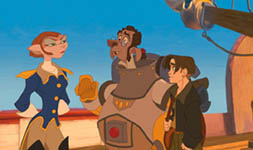
![]() Thomas Schumacher,
President of Walt Disney Feature Animation revealed in October 2002 that
future direct-to-video releases and a television series are already being
considered. "We’ve got a story and some storyboards and concepts up and
a script for a what a sequel to this could be. There’s also a notion of
what a series could be. I have all the pieces in place and should we [decide]
to push the button, we push the button and go with it."
Thomas Schumacher,
President of Walt Disney Feature Animation revealed in October 2002 that
future direct-to-video releases and a television series are already being
considered. "We’ve got a story and some storyboards and concepts up and
a script for a what a sequel to this could be. There’s also a notion of
what a series could be. I have all the pieces in place and should we [decide]
to push the button, we push the button and go with it."
![]() In October 2002,
directors Ron Clements and John Musker said they would not rule out the
possibility of directing another animated science fiction feature: "It’s
possible, sure. I don’t think the genre’s exhausted. For us, we like to
have variance from one film to another but, it’s a field that still has
interesting stories to be told." While it is clear that Clements and Musker
want to return to science fiction for another feature, they are remaining
quiet on whether or not they would develop something original or try another
adaptation. "We’re kicking around ideas. "We’re at a stage where we can’t
really talk about [what we’re going to do]. But all of that, I think."
In October 2002,
directors Ron Clements and John Musker said they would not rule out the
possibility of directing another animated science fiction feature: "It’s
possible, sure. I don’t think the genre’s exhausted. For us, we like to
have variance from one film to another but, it’s a field that still has
interesting stories to be told." While it is clear that Clements and Musker
want to return to science fiction for another feature, they are remaining
quiet on whether or not they would develop something original or try another
adaptation. "We’re kicking around ideas. "We’re at a stage where we can’t
really talk about [what we’re going to do]. But all of that, I think."
![]() "It sort of went
from nautical world to a science fiction world," explained John Musker.
"Islands become planets, the peg-legged pirate becomes a cyborg, the parrot
on his shoulder becomes a blob of protoplasm. From the earliest go-round
there was this kind of romantic archetypal image that we wanted, and we
had to create a universe that supported that. So that's why we didn't say
'It's the future of this universe,' because we wanted to have breathable
atmospheres and no guys in bubble helmets. It had to be an alternate world
– we were influenced by Terry Gilliam and his fantasy worlds." The duo
also had to find the right voice talent to fill out their tale, and managed
to snag Oscar-winner Emma Thompson. "We offered it to her and she was really
excited. "She sent us a lovely note saying 'I get to do an action film
without having a train at all!'"
"It sort of went
from nautical world to a science fiction world," explained John Musker.
"Islands become planets, the peg-legged pirate becomes a cyborg, the parrot
on his shoulder becomes a blob of protoplasm. From the earliest go-round
there was this kind of romantic archetypal image that we wanted, and we
had to create a universe that supported that. So that's why we didn't say
'It's the future of this universe,' because we wanted to have breathable
atmospheres and no guys in bubble helmets. It had to be an alternate world
– we were influenced by Terry Gilliam and his fantasy worlds." The duo
also had to find the right voice talent to fill out their tale, and managed
to snag Oscar-winner Emma Thompson. "We offered it to her and she was really
excited. "She sent us a lovely note saying 'I get to do an action film
without having a train at all!'"
![]() Animator Glen
Keane commented in November 2002: "I think Disney is at a crossroads right
now--where we're going in terms of the future and because of the economic
crisis in the United States. It's forcing Disney to look at what is really
crucial and what is its foundation. And animation will always be that foundation."
Animator Glen
Keane commented in November 2002: "I think Disney is at a crossroads right
now--where we're going in terms of the future and because of the economic
crisis in the United States. It's forcing Disney to look at what is really
crucial and what is its foundation. And animation will always be that foundation."
![]() The entire movie
was specifically made so that it reflects the likeness of Brandywine painters,
a group of American illustrators, including N.C. Wyeth and Maxfield Parrish,
made famous for their oil paintings during the 17th century. "We liked
the warmth of the 17th century," John Musker explained. "That was the look
we really wanted to have in the movie." But because oil paint takes too
long to dry--as far as movie animation is concerned--a duplicate look was
created with computerized technology. The entire movie is actually a fusion
of two and three-dimensional animation, created both the traditional way
and with computer graphics. For example, the character of galleon cook
John Silver--who is part man, part machine--has a computer generated arm,
eye and leg. "It's a combination of 2-D and 3-D, so we like to say it's
5-D," Musker said.
The entire movie
was specifically made so that it reflects the likeness of Brandywine painters,
a group of American illustrators, including N.C. Wyeth and Maxfield Parrish,
made famous for their oil paintings during the 17th century. "We liked
the warmth of the 17th century," John Musker explained. "That was the look
we really wanted to have in the movie." But because oil paint takes too
long to dry--as far as movie animation is concerned--a duplicate look was
created with computerized technology. The entire movie is actually a fusion
of two and three-dimensional animation, created both the traditional way
and with computer graphics. For example, the character of galleon cook
John Silver--who is part man, part machine--has a computer generated arm,
eye and leg. "It's a combination of 2-D and 3-D, so we like to say it's
5-D," Musker said.

![]() Producer Roy
Conli explained that "there is always a very long process of auditions.
Obviously as your writing the film a lot of actors come to mind. We knew,
Emma Thompson was definitely ther voice we wanted for Captain Amelia. For
Silver and Jim, we auditioned for seven to eight months before we found
them. "
Producer Roy
Conli explained that "there is always a very long process of auditions.
Obviously as your writing the film a lot of actors come to mind. We knew,
Emma Thompson was definitely ther voice we wanted for Captain Amelia. For
Silver and Jim, we auditioned for seven to eight months before we found
them. "
![]() The cyborg Silver,
a highly complicated blend of hand-drawn and computer-generated elements,
embodies this hybrid aesthetic more than any other character in the film.
"The hand-drawn being kind of 2-D, and the computer-generated 3-D, some
us here like to say that Silver was the first '5-D' character," president
of Walt Disney Feature Animation Thomas Schumacher proudly said. Veteran
animator Keane designed Silver and personally animated the flesh-and-blood
half of the character. Yet, as experienced as he is, Keane readily admits
that when it came to animating the mechanical half of cinema’s first 5-D
character, he needed some technical assistance. "I mean, I can do organic
expressions and all that very easily. That just kind of flows out of me.
On the other hand, I can’t even operate my e-mail, and I needed somebody
who really knew how to use a computer." That’s where CGI animator Eric
Daniels came in. He and Keane spent months designing Silver’s mechanical
arm, leg and eye. For inspiration during the creative process, Daniels
drove around Los Angeles to analyze antique machinery. "The more they felt
like throwbacks to the past, the better it was," says Daniels. "Ultimately,
Silver’s leg was based on some ancient dry-cleaning machinery I came across,"
while his arm is "basically a cross between a Swiss army knife and a juke
box." Once the design was settled, Daniels animated the movements of Silver’s
arm and leg, which were then added to each of Keane’s hand-drawn frames.
"Silver is the most complex character I’ve ever done, and I think he’s
probably the most complex we’ve ever done at Disney," admits Keane. But
he wouldn’t have had it any other way. "I didn’t design him because it
was easy," Keane says matter-of-factly. "I designed him because that’s
who he demanded to be."
The cyborg Silver,
a highly complicated blend of hand-drawn and computer-generated elements,
embodies this hybrid aesthetic more than any other character in the film.
"The hand-drawn being kind of 2-D, and the computer-generated 3-D, some
us here like to say that Silver was the first '5-D' character," president
of Walt Disney Feature Animation Thomas Schumacher proudly said. Veteran
animator Keane designed Silver and personally animated the flesh-and-blood
half of the character. Yet, as experienced as he is, Keane readily admits
that when it came to animating the mechanical half of cinema’s first 5-D
character, he needed some technical assistance. "I mean, I can do organic
expressions and all that very easily. That just kind of flows out of me.
On the other hand, I can’t even operate my e-mail, and I needed somebody
who really knew how to use a computer." That’s where CGI animator Eric
Daniels came in. He and Keane spent months designing Silver’s mechanical
arm, leg and eye. For inspiration during the creative process, Daniels
drove around Los Angeles to analyze antique machinery. "The more they felt
like throwbacks to the past, the better it was," says Daniels. "Ultimately,
Silver’s leg was based on some ancient dry-cleaning machinery I came across,"
while his arm is "basically a cross between a Swiss army knife and a juke
box." Once the design was settled, Daniels animated the movements of Silver’s
arm and leg, which were then added to each of Keane’s hand-drawn frames.
"Silver is the most complex character I’ve ever done, and I think he’s
probably the most complex we’ve ever done at Disney," admits Keane. But
he wouldn’t have had it any other way. "I didn’t design him because it
was easy," Keane says matter-of-factly. "I designed him because that’s
who he demanded to be."
![]() David Hyde Pierce
didn't want the canine character Dr. Doppler to recall Dr. Niles Crane,
the high-strung psychiatrist he plays on the hit show Fraiser. "[Doppler]
is very intelligent, very uptight, nervous and nerdy and all that, so I
am aware my line readings aren't too Nilesy. If he gets too verbose in
a certain way, it would draw attention. I do see myself in Doppler but
in a subtle way. We were just looking at the early sketches here in the
Disney Animation Building, and it's amazing to see how they meld you into
this creature they've created--and the timing, which is the most important
thing in comedy."
David Hyde Pierce
didn't want the canine character Dr. Doppler to recall Dr. Niles Crane,
the high-strung psychiatrist he plays on the hit show Fraiser. "[Doppler]
is very intelligent, very uptight, nervous and nerdy and all that, so I
am aware my line readings aren't too Nilesy. If he gets too verbose in
a certain way, it would draw attention. I do see myself in Doppler but
in a subtle way. We were just looking at the early sketches here in the
Disney Animation Building, and it's amazing to see how they meld you into
this creature they've created--and the timing, which is the most important
thing in comedy."

![]() "The computer
is great for symmetry and mechanical perfection—a machine drawing a machine,"
said animator Glen Keane, who drew and supervised John Silver's organic
side. "Humans are better at imperfection... which works best for the expressive
and emotional parts." Silver's steely hand had so many tiny gears and hydraulic
pistons that swivel, twist and clench that Keane estimated it would have
taken three decades to hand-animate it. The computerized arm also served
the story thematically, Treasure Planet co-director John Musker told AP.
"All the characters have a missing piece," he said, and Silver's robotic
side represents the humanity he sacrificed during his life of buccaneering."
Once the dimensions of the robotic limb were programmed, digital animator
Eric Daniels pushed, pulled and turned its components on the screen instead
of repeatedly redrawing them. "There is an element of puppetry there in
terms of how you have to maneuver the arm," said producer Roy Conli. "You
can't think of a computer as just a very expensive pencil." Keane started
the process by sketching the stubbly, bulbous body of the pirate with only
a crude outline of the mechanized side. Daniels then laid the gesticulating
intricacies of the computerized parts atop Keane's drawings. Once both
elements were in place, they were colored and shaded to create the illusion
that the entire character was illustrated by hand. Digital technology also
allowed the filmmakers to replace static, painted backgrounds with "virtual
sets"--computerized 3-D models that can bustle with activity and be photographed,
lit and reused like live-action locations. The designs were an extension
of Disney Animation's "deep canvas" work in 1999's Tarzan,
in which the 2-D ape-man hero animated by Keane swung and slid through
a three-dimensional jungle created by Daniels.
"The computer
is great for symmetry and mechanical perfection—a machine drawing a machine,"
said animator Glen Keane, who drew and supervised John Silver's organic
side. "Humans are better at imperfection... which works best for the expressive
and emotional parts." Silver's steely hand had so many tiny gears and hydraulic
pistons that swivel, twist and clench that Keane estimated it would have
taken three decades to hand-animate it. The computerized arm also served
the story thematically, Treasure Planet co-director John Musker told AP.
"All the characters have a missing piece," he said, and Silver's robotic
side represents the humanity he sacrificed during his life of buccaneering."
Once the dimensions of the robotic limb were programmed, digital animator
Eric Daniels pushed, pulled and turned its components on the screen instead
of repeatedly redrawing them. "There is an element of puppetry there in
terms of how you have to maneuver the arm," said producer Roy Conli. "You
can't think of a computer as just a very expensive pencil." Keane started
the process by sketching the stubbly, bulbous body of the pirate with only
a crude outline of the mechanized side. Daniels then laid the gesticulating
intricacies of the computerized parts atop Keane's drawings. Once both
elements were in place, they were colored and shaded to create the illusion
that the entire character was illustrated by hand. Digital technology also
allowed the filmmakers to replace static, painted backgrounds with "virtual
sets"--computerized 3-D models that can bustle with activity and be photographed,
lit and reused like live-action locations. The designs were an extension
of Disney Animation's "deep canvas" work in 1999's Tarzan,
in which the 2-D ape-man hero animated by Keane swung and slid through
a three-dimensional jungle created by Daniels.
![]() Asked why Disney
took the "Long" out of John Silver's name, Glen Keane admitted: "I never
got a clear explanation of that, but I can't help but think they wanted
to avoid any possible double entendres." About his character, Glen added:
""The challenge was to connect the mechanical to Silver's heart and soul,
as though it was attached to the nerves. We wanted the movement to be naturalistic,
revealing something of his character. Walking out of the studio one day,
I realized that Silver was no longer on the drawing board. He was as real
as anybody. It was as though I could put my hand on his shoulder. A character,
if done right, takes on a life of his own. Not until that happens will
the audience believe in him."
Asked why Disney
took the "Long" out of John Silver's name, Glen Keane admitted: "I never
got a clear explanation of that, but I can't help but think they wanted
to avoid any possible double entendres." About his character, Glen added:
""The challenge was to connect the mechanical to Silver's heart and soul,
as though it was attached to the nerves. We wanted the movement to be naturalistic,
revealing something of his character. Walking out of the studio one day,
I realized that Silver was no longer on the drawing board. He was as real
as anybody. It was as though I could put my hand on his shoulder. A character,
if done right, takes on a life of his own. Not until that happens will
the audience believe in him."
![]() Having stripes
on John Silver's pants would have been too expensive to animated, hence
its plain-colored pants in the movie.
Having stripes
on John Silver's pants would have been too expensive to animated, hence
its plain-colored pants in the movie.
![]() Both directors
are in the movie. At the spaceport, when Jim and Dr. Doppler are asking
for directions they ask a robot and an alien who are effectively, Ron Clements
and John Musker.
Both directors
are in the movie. At the spaceport, when Jim and Dr. Doppler are asking
for directions they ask a robot and an alien who are effectively, Ron Clements
and John Musker.

![]() Animator Glen
Keane and producer Roy Conli revealed during an online chat in November
2002 that about half the movie was created using traditional animation
techniques, while the other half used computers: "A majority of the character
animation was drawn by hand. Ben was all CG. Robocops all CG. John Silver
50/50. The majority of lay-outs and backgrounds were CG. [Computer animation]
is basically a tool that allows us to create visually what we want. There
are some things that are nearly impossible for an artist to draw by hand,
that the computer can do very quickly and easily. So, in that way, it simplifies
things."
Animator Glen
Keane and producer Roy Conli revealed during an online chat in November
2002 that about half the movie was created using traditional animation
techniques, while the other half used computers: "A majority of the character
animation was drawn by hand. Ben was all CG. Robocops all CG. John Silver
50/50. The majority of lay-outs and backgrounds were CG. [Computer animation]
is basically a tool that allows us to create visually what we want. There
are some things that are nearly impossible for an artist to draw by hand,
that the computer can do very quickly and easily. So, in that way, it simplifies
things."
![]() The movie took
three-and-a-half to four years to complete, with production and pre-production.
The movie took
three-and-a-half to four years to complete, with production and pre-production.
![]() "We pretty much
worked on this film in the same way we’ve worked in the past," director
Ron Clements said. "We start by creating an outline together. John [Musker]
is the first to write and he comes up with reams of ideas and improvisations.
I bring all his ideas together with mine and write a script. He’ll take
the rough draft of the script and tweak it and then it goes back and forth.
Once we get into production, we divide the movie into scenes. We both get
involved in recording the voice talents." Producer Ray Conti comments that
"it’s magic how they work together. They’re incredibly passionate about
what they want and they’re incredibly giving with all their collaborations
on the film. They finish each other’s sentences and they seem to have a
telepathic communication between them. They usually think pretty much alike
but when they don’t, they make what they’re thinking known to one another.
There’s definitely a healthy dialogue going back and forth. They
really understand animation and have a great sense of storyboarding, and
a great visual sense of storytelling." Art Director Andy Gaskill adds that
"what’s really interesting about them is that they listen to everyone.
Anyone can offer advice, a suggestion or an opinion after each screening.
Ron and John encourage the entire crew to write notes. Even though they
have a specific idea of the kind of story they want to tell, they still
leave it wide open for other ideas. If they get one note that contradicts
what they’re doing, they may not take it seriously. But if they get 10
notes that contradict, they’ll look at it and want to explore other opinions.
They’re humorous, easy going and you feel like you can always say what’s
on your mind." Animator Glen Keane concludes by observing that "they really
are the animator’s director. They think like animators and they’re sensitive
to an animator’s needs. Acting is paramount. They are willing to change
a lot to accommodate acting in the picture. They truly are the dream directors
for animators."
"We pretty much
worked on this film in the same way we’ve worked in the past," director
Ron Clements said. "We start by creating an outline together. John [Musker]
is the first to write and he comes up with reams of ideas and improvisations.
I bring all his ideas together with mine and write a script. He’ll take
the rough draft of the script and tweak it and then it goes back and forth.
Once we get into production, we divide the movie into scenes. We both get
involved in recording the voice talents." Producer Ray Conti comments that
"it’s magic how they work together. They’re incredibly passionate about
what they want and they’re incredibly giving with all their collaborations
on the film. They finish each other’s sentences and they seem to have a
telepathic communication between them. They usually think pretty much alike
but when they don’t, they make what they’re thinking known to one another.
There’s definitely a healthy dialogue going back and forth. They
really understand animation and have a great sense of storyboarding, and
a great visual sense of storytelling." Art Director Andy Gaskill adds that
"what’s really interesting about them is that they listen to everyone.
Anyone can offer advice, a suggestion or an opinion after each screening.
Ron and John encourage the entire crew to write notes. Even though they
have a specific idea of the kind of story they want to tell, they still
leave it wide open for other ideas. If they get one note that contradicts
what they’re doing, they may not take it seriously. But if they get 10
notes that contradict, they’ll look at it and want to explore other opinions.
They’re humorous, easy going and you feel like you can always say what’s
on your mind." Animator Glen Keane concludes by observing that "they really
are the animator’s director. They think like animators and they’re sensitive
to an animator’s needs. Acting is paramount. They are willing to change
a lot to accommodate acting in the picture. They truly are the dream directors
for animators."
![]() This is the first
Disney film in which the maquettes (small reference sculptures of the characters)
were not made entirely by hand, out of clay. Silver's cyborg parts were
constructed out of plastic, using laser technology.
This is the first
Disney film in which the maquettes (small reference sculptures of the characters)
were not made entirely by hand, out of clay. Silver's cyborg parts were
constructed out of plastic, using laser technology.
![]() The animators
visited a Benihana restaurant to take notes for the scene where John Silver
chops shrimp.
The animators
visited a Benihana restaurant to take notes for the scene where John Silver
chops shrimp.
![]() The performance
of Jim Hawkins was based in part on James Dean.
The performance
of Jim Hawkins was based in part on James Dean.
![]() The name of the
ship, "R.L.S. Legacy" is a reference to the book's ("Treasure Island")
author, Robert Louis Stevenson.
The name of the
ship, "R.L.S. Legacy" is a reference to the book's ("Treasure Island")
author, Robert Louis Stevenson.
![]() Dr. Doppler paraphrases
Dr. McCoy of Star Trek when he proclaims "Darn it, Jim, I'm an astronomer,
not a doctor!"
Dr. Doppler paraphrases
Dr. McCoy of Star Trek when he proclaims "Darn it, Jim, I'm an astronomer,
not a doctor!"
![]() One of the seven
dwarfs gets off of the ship at the space port right before Jim does.
One of the seven
dwarfs gets off of the ship at the space port right before Jim does.
![]() The $140 milion
movie went down in Disney history as the studio's first clear money-loser--Disney
expects the pretax loss on Treasure Planet to come to $74 million.
The company had previously planned for a video sequel, but it's will likely
be shelved, and many of the other ancillary projects that could have been
developed around the film also may not materialize. The movie is
considered the last of the Mouse House' mega-budget animated films.
The $140 milion
movie went down in Disney history as the studio's first clear money-loser--Disney
expects the pretax loss on Treasure Planet to come to $74 million.
The company had previously planned for a video sequel, but it's will likely
be shelved, and many of the other ancillary projects that could have been
developed around the film also may not materialize. The movie is
considered the last of the Mouse House' mega-budget animated films.
![]() Asked about the
Treasure
Planet debacle in the U.S., studio chairman Richard Cook commented:
"I don't think it says anything about Disney. All it says is that, for
this particular Thanksgiving weekend, this movie didn't perform as well
as we'd anticipated. For whatever reason, we did not make it look appealing
enough."
Asked about the
Treasure
Planet debacle in the U.S., studio chairman Richard Cook commented:
"I don't think it says anything about Disney. All it says is that, for
this particular Thanksgiving weekend, this movie didn't perform as well
as we'd anticipated. For whatever reason, we did not make it look appealing
enough."
![]() Jim
Hill reveals that "according to internal Disney Studio documents that
were passed along to me earlier this week, the only reason that Treasure
Planet has done as well as it has is because of folks like you: the
big time animation buffs. It seems like you're the only ones who actually
went out of their way to catch TP during its initial theatrical
release. According to Disney's own marketing surveys, the number one reason
that people said they were opting not to see this movie while it was in
theaters was because they were eventually intending to buy Treasure
Planet when the film came out on video or DVD. Imagine Mickey's horror
when he learned this: that consumers had finally caught on to the Walt
Disney Company's release patterns. Gone are the days when--if you didn't
catch a Disney animated cartoon while it was out in theaters--you'd have
to wait another seven years before you got a chance to see this movie again.
Nowadays, just like clockwork, the video and DVD version of every film
predictably pops up for sale, just a few months after the film falls out
of theaters. This explains why the Walt Disney Company has been so eager
to embrace the idea of exhibiting its newest animated films in the IMAX
format. Thereby creating a cinematic experience that the typical consumer
would never be able to replicate with their own home entertainment system.
The Walt Disney Company isn't going to abandon its highly lucrative practice
of putting its latest animated features up for sale in the home video and
DVD format as soon as humanly possible since it now relies quite heavily
on the cash that it receives from the sale of these DVDs and videos to
bolster the corporation's bottom line. With a project like Treasure
Planet, it's important to remember that--what with the money that Disney
will make off of the overseas release of TP, plus factoring in the
monies that will eventually be made off of pay-per-view, home video and
DVD sales, the awarding of network broadcasting rights and the like--that
the money that a movie makes off of its initial domestic release is really
just the beginning. Truth be told, these days, the domestic gross only
accounts for about 1/5th of a film's eventual earning power. So it stands
to reason that Treasure Planet (just like those other historic Disney
under-performers like the original Fantasia
and Sleeping Beauty) will eventually
make some big bucks for the Mouse."
Jim
Hill reveals that "according to internal Disney Studio documents that
were passed along to me earlier this week, the only reason that Treasure
Planet has done as well as it has is because of folks like you: the
big time animation buffs. It seems like you're the only ones who actually
went out of their way to catch TP during its initial theatrical
release. According to Disney's own marketing surveys, the number one reason
that people said they were opting not to see this movie while it was in
theaters was because they were eventually intending to buy Treasure
Planet when the film came out on video or DVD. Imagine Mickey's horror
when he learned this: that consumers had finally caught on to the Walt
Disney Company's release patterns. Gone are the days when--if you didn't
catch a Disney animated cartoon while it was out in theaters--you'd have
to wait another seven years before you got a chance to see this movie again.
Nowadays, just like clockwork, the video and DVD version of every film
predictably pops up for sale, just a few months after the film falls out
of theaters. This explains why the Walt Disney Company has been so eager
to embrace the idea of exhibiting its newest animated films in the IMAX
format. Thereby creating a cinematic experience that the typical consumer
would never be able to replicate with their own home entertainment system.
The Walt Disney Company isn't going to abandon its highly lucrative practice
of putting its latest animated features up for sale in the home video and
DVD format as soon as humanly possible since it now relies quite heavily
on the cash that it receives from the sale of these DVDs and videos to
bolster the corporation's bottom line. With a project like Treasure
Planet, it's important to remember that--what with the money that Disney
will make off of the overseas release of TP, plus factoring in the
monies that will eventually be made off of pay-per-view, home video and
DVD sales, the awarding of network broadcasting rights and the like--that
the money that a movie makes off of its initial domestic release is really
just the beginning. Truth be told, these days, the domestic gross only
accounts for about 1/5th of a film's eventual earning power. So it stands
to reason that Treasure Planet (just like those other historic Disney
under-performers like the original Fantasia
and Sleeping Beauty) will eventually
make some big bucks for the Mouse."
![]() Treasure Planet
is the last of the films to be made using more costly, complex and labor-intensive
animation processes. Future films will, as did Lilo
& Stitch, use newer techniques to cut costs, like simplifying
much of the animation and using computers to do more of the work.
Treasure Planet
is the last of the films to be made using more costly, complex and labor-intensive
animation processes. Future films will, as did Lilo
& Stitch, use newer techniques to cut costs, like simplifying
much of the animation and using computers to do more of the work.
![]() Studios usually
throw their publicity and marketing machines into high gear when one of
their movies receives an Oscar nomination. But that machine was idle when
it came to Treasure Planet, which earned a nod as one of the five
best 2002 animated features despite being the biggest flop in Walt Disney
Co.'s storied moviemaking history. "It was a shock," one Disney insider
revealed a day after the nominations were announced. In a sign of just
how much studio executives were caught off guard by their good fortune,
the source added, it hadn't even occurred to them to discuss a strategy
for capitalizing on a potential nomination. The Oscar accolade for Treasure
Planet now puts Disney in an unusual quandary. Does the studio spend
millions of new marketing dollars to exploit an Oscar nomination that could
breathe life into a movie that initially failed so badly? Or does the Burbank-based
entertainment giant play it safe, refusing to throw good money after bad?
Adding to the studio's dilemma is that the core audience for Treasure
Planet is young children. "Oscar nominations may give a film cachet
for adults, but kids could care less about Oscar nominations," said Paul
Dergarabedian, president of box-office tracking firm Exhibitor Relations
Co. "Sometimes a movie cannot transcend its status as a box-office failure."
Disney would not comment on whether it plans to create a new marketing
campaign built around the nomination or expand the showing of Treasure
Planet, which is still in 312 theaters nationwide. Studios commonly
use nominations and awards as marketing tools to help sell their movies
a second time. The results can vary dramatically. Last year's animated
Oscar nominees, Shrek,
Monsters,
Inc. and Jimmy Neutron
did not see any box-office boost; they were already big hits by the time
they were recognized by the Academy of Motion Picture Arts and Sciences.
It is unclear how much Treasure Planet might benefit from being
nominated. By all accounts, the movie was a money loser of un- precedented
proportions for Disney. Analysts said any potential gains that the movie
might get either from a rerelease in theaters or from home video and DVD
sales would have a minimal financial effect on Disney's bottom line. "It's
not going to cause us to change our numbers," said David Miller, an analyst
with Sanders Morris Harris Group in Los Angeles. Shortly after the premiere
of Treasure Planet, Disney management speculated that misguided
marketing may have hurt the movie's reception. "Maybe we didn't do a good
enough job to entice an audience to want to come," Disney Studios Chairman
Dick Cook said at the time. "Maybe we were too serious and earnest in the
marketing." Treasure Planet producer Roy Conli said he hopes that
in light of the Oscar nod, Disney would do everything it can to widen the
movie's reach. He, like many others who worked on the film, believe it
could find a niche. "I would love to see this movie get its due on the
big screen," Conli said. "Everyone kept telling me, 'It will be fine, you'll
get the sales on DVD and video,' but this film is just so magical you need
to experience it in the theater."
Studios usually
throw their publicity and marketing machines into high gear when one of
their movies receives an Oscar nomination. But that machine was idle when
it came to Treasure Planet, which earned a nod as one of the five
best 2002 animated features despite being the biggest flop in Walt Disney
Co.'s storied moviemaking history. "It was a shock," one Disney insider
revealed a day after the nominations were announced. In a sign of just
how much studio executives were caught off guard by their good fortune,
the source added, it hadn't even occurred to them to discuss a strategy
for capitalizing on a potential nomination. The Oscar accolade for Treasure
Planet now puts Disney in an unusual quandary. Does the studio spend
millions of new marketing dollars to exploit an Oscar nomination that could
breathe life into a movie that initially failed so badly? Or does the Burbank-based
entertainment giant play it safe, refusing to throw good money after bad?
Adding to the studio's dilemma is that the core audience for Treasure
Planet is young children. "Oscar nominations may give a film cachet
for adults, but kids could care less about Oscar nominations," said Paul
Dergarabedian, president of box-office tracking firm Exhibitor Relations
Co. "Sometimes a movie cannot transcend its status as a box-office failure."
Disney would not comment on whether it plans to create a new marketing
campaign built around the nomination or expand the showing of Treasure
Planet, which is still in 312 theaters nationwide. Studios commonly
use nominations and awards as marketing tools to help sell their movies
a second time. The results can vary dramatically. Last year's animated
Oscar nominees, Shrek,
Monsters,
Inc. and Jimmy Neutron
did not see any box-office boost; they were already big hits by the time
they were recognized by the Academy of Motion Picture Arts and Sciences.
It is unclear how much Treasure Planet might benefit from being
nominated. By all accounts, the movie was a money loser of un- precedented
proportions for Disney. Analysts said any potential gains that the movie
might get either from a rerelease in theaters or from home video and DVD
sales would have a minimal financial effect on Disney's bottom line. "It's
not going to cause us to change our numbers," said David Miller, an analyst
with Sanders Morris Harris Group in Los Angeles. Shortly after the premiere
of Treasure Planet, Disney management speculated that misguided
marketing may have hurt the movie's reception. "Maybe we didn't do a good
enough job to entice an audience to want to come," Disney Studios Chairman
Dick Cook said at the time. "Maybe we were too serious and earnest in the
marketing." Treasure Planet producer Roy Conli said he hopes that
in light of the Oscar nod, Disney would do everything it can to widen the
movie's reach. He, like many others who worked on the film, believe it
could find a niche. "I would love to see this movie get its due on the
big screen," Conli said. "Everyone kept telling me, 'It will be fine, you'll
get the sales on DVD and video,' but this film is just so magical you need
to experience it in the theater."
![]() The home video
debut of Treasure Planet got off to a fairly good start on VHS and
DVD, selling more than 1 million combined units its first day in release
on April 29, 2003. It easily exceeded its nearly $40 million domestic
box office gross within the first week of release.
The home video
debut of Treasure Planet got off to a fairly good start on VHS and
DVD, selling more than 1 million combined units its first day in release
on April 29, 2003. It easily exceeded its nearly $40 million domestic
box office gross within the first week of release.
![]() Writer and Disney
insider 'ActingforAnimators' shared on the Benbow Inn Hearth Chat Website
why he thought Treasure Planet bombed at the box office: ""For the
record: The film was budgeted from the outset--over eight years ago--at
$140 Million dollars. It NEVER climbed, it NEVER got out of hand, and in
fact it actually came in at $130 Million - that's $10 Million under budget.
The $140 Million is the budget, and it's a sham when Disney says that's
what they lost. The film failed at the box office because it had no internal
support beyond its Executive Producer. Tom Schumacher openly disliked the
directors and was their enemy at all times, and those close to him in 'his
camp'--if you will--followed suit and degraded the film constantly. Marketing
was half-assed and lazy and unoriginal, and the directors were purposefully
kept out of the decisions until it was far too late. They didn't even let
them cut a proper trailer until two weeks out. Michael Eisner was under
the threat of a possible SEC investigation, and by declaring the film a
loss before it had even finished its first weekend the company was able
to satisfy some questions about earnings for that quarter and deflect unwanted
attention in the press elsewhere. The film was scuttled from within on
the highest level and it is one of the most ugly, despicable and underhanded
things ever to happen to a truly good film. That from the third day of
release onward, internal Disney spokespeople were allowed to refer to it
as 'a flop' is unprecedented and shameful. The only person who had half
the guts to speak to the truth--or at least hint toward it--was Dick Cook
who said that they had done a poor job marketing it and that the timing
of the release was not the best. He was quickly shut up after making that
remark, and the rest is history. It is an extraordinary and wonderful addition
to the Disney animation legacy. No, it does not look like Lilo
& Stitch. No it does not look like Beauty
and the Beast. No it doesn't look like anything else the studio
has ever done. And that is a very good thing. On its own, seen with objectivity
and uncolored by what the press may have said, I'd dare say the majority
of audiences would rank it as a terrific film. I believe that history and
time will win it a proper appreciation." 'ActingforAnimators' later added
that "Mssrs. Clements and Musker were not liked by Mr. Schumacher. And
it was an openly acknowledged dislike. They were kept under a much, much,
much tighter control and the marketing of Treasure Planet was something
that was all but dictated to them, and its marketing budget was considerably
less than Lilo and Stitch. It is terribly important in this discussion
to remember that Chris Sanders was VERY much a favorite of Tom Schumacher,
and it was obvious. While Mr. Sanders in NO WAY played into that, he knew
that he had an advantage, and he made it a condition of his contract that
he oversee the development of the promotional and advertising campaign
for Lilo & Stitch. That campaign
was almost 100% the devising of the Director. The animators who did the
"interStitchials" were the same team that animated the film. When the principal
animation on the feature wrapped, Disney's best and brightest were animating
that campaign, and it was not cheap (and for some odd reason they're never
factored into numbers for L&S that are tossed around when comparing
its cost to other features.) That was nearly six months before the film
was in theatres. Mr. Sanders and Mr. Deblois knew how to market their product
and they were given the opportunity to do so. I repeat, this film was scuttled
from within."
Writer and Disney
insider 'ActingforAnimators' shared on the Benbow Inn Hearth Chat Website
why he thought Treasure Planet bombed at the box office: ""For the
record: The film was budgeted from the outset--over eight years ago--at
$140 Million dollars. It NEVER climbed, it NEVER got out of hand, and in
fact it actually came in at $130 Million - that's $10 Million under budget.
The $140 Million is the budget, and it's a sham when Disney says that's
what they lost. The film failed at the box office because it had no internal
support beyond its Executive Producer. Tom Schumacher openly disliked the
directors and was their enemy at all times, and those close to him in 'his
camp'--if you will--followed suit and degraded the film constantly. Marketing
was half-assed and lazy and unoriginal, and the directors were purposefully
kept out of the decisions until it was far too late. They didn't even let
them cut a proper trailer until two weeks out. Michael Eisner was under
the threat of a possible SEC investigation, and by declaring the film a
loss before it had even finished its first weekend the company was able
to satisfy some questions about earnings for that quarter and deflect unwanted
attention in the press elsewhere. The film was scuttled from within on
the highest level and it is one of the most ugly, despicable and underhanded
things ever to happen to a truly good film. That from the third day of
release onward, internal Disney spokespeople were allowed to refer to it
as 'a flop' is unprecedented and shameful. The only person who had half
the guts to speak to the truth--or at least hint toward it--was Dick Cook
who said that they had done a poor job marketing it and that the timing
of the release was not the best. He was quickly shut up after making that
remark, and the rest is history. It is an extraordinary and wonderful addition
to the Disney animation legacy. No, it does not look like Lilo
& Stitch. No it does not look like Beauty
and the Beast. No it doesn't look like anything else the studio
has ever done. And that is a very good thing. On its own, seen with objectivity
and uncolored by what the press may have said, I'd dare say the majority
of audiences would rank it as a terrific film. I believe that history and
time will win it a proper appreciation." 'ActingforAnimators' later added
that "Mssrs. Clements and Musker were not liked by Mr. Schumacher. And
it was an openly acknowledged dislike. They were kept under a much, much,
much tighter control and the marketing of Treasure Planet was something
that was all but dictated to them, and its marketing budget was considerably
less than Lilo and Stitch. It is terribly important in this discussion
to remember that Chris Sanders was VERY much a favorite of Tom Schumacher,
and it was obvious. While Mr. Sanders in NO WAY played into that, he knew
that he had an advantage, and he made it a condition of his contract that
he oversee the development of the promotional and advertising campaign
for Lilo & Stitch. That campaign
was almost 100% the devising of the Director. The animators who did the
"interStitchials" were the same team that animated the film. When the principal
animation on the feature wrapped, Disney's best and brightest were animating
that campaign, and it was not cheap (and for some odd reason they're never
factored into numbers for L&S that are tossed around when comparing
its cost to other features.) That was nearly six months before the film
was in theatres. Mr. Sanders and Mr. Deblois knew how to market their product
and they were given the opportunity to do so. I repeat, this film was scuttled
from within."
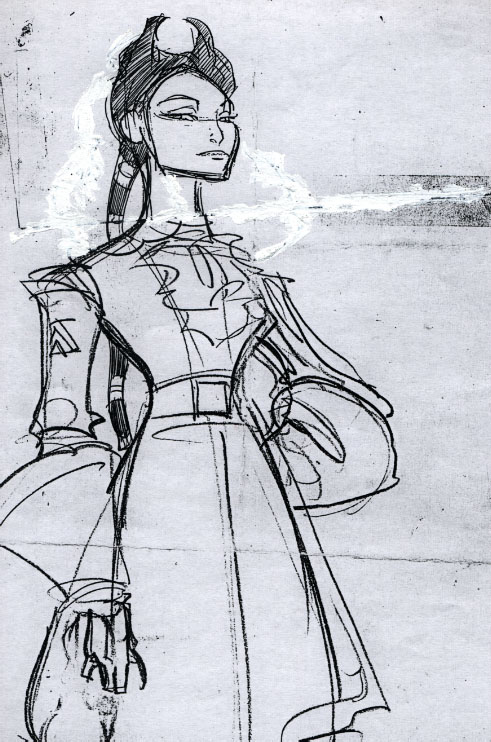 |
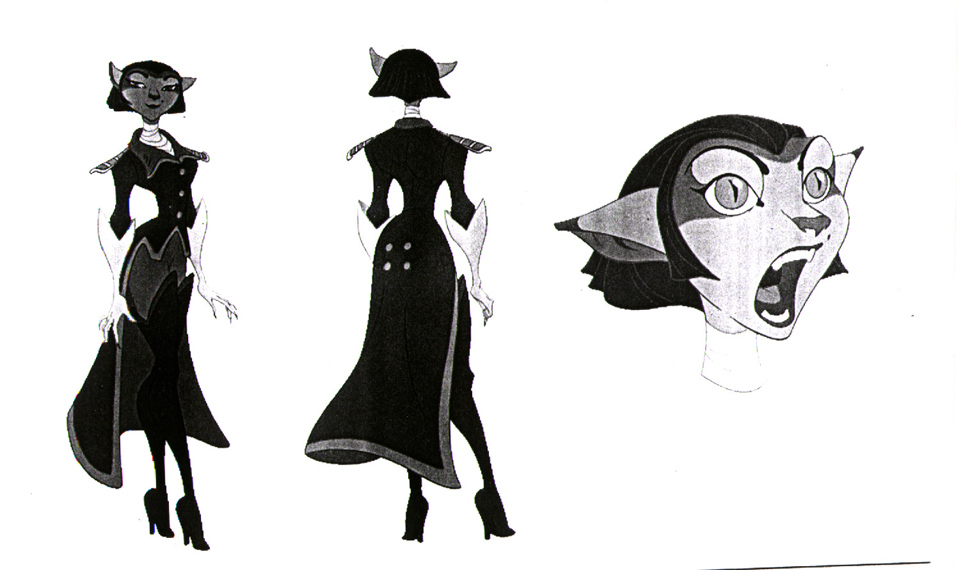 |
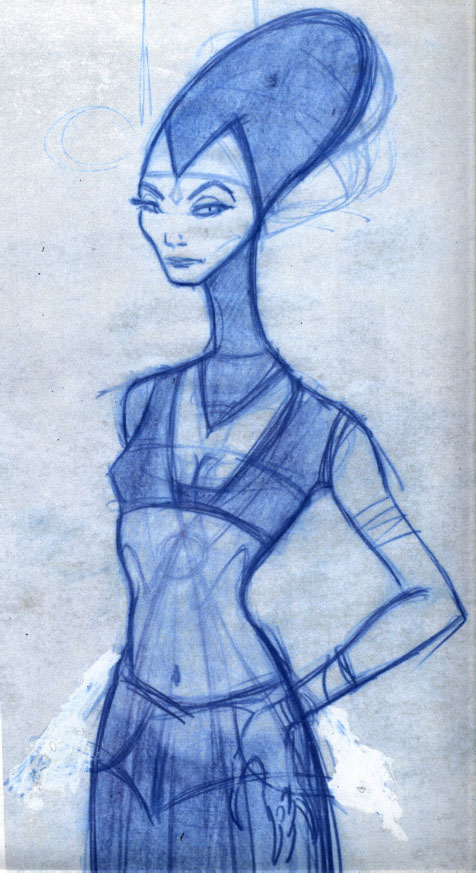 |
Based on the December 6, 2002 article "Disney's Treasure Planet an Adventure in Losing Money" originally published in the Los Angeles Times
The idea for Treasure Planet dates back to 1985. At the time, Disney's feature animation division held a "gong show" of sorts to scout for new ideas. One of the first pitched by Clements was "Treasure Island in Space," according to the movie's press notes. He brought aboard collaborator Musker, with whom he wrote and directed the 1986 animated movie The Great Mouse Detective.
Although the Treasure Island project was enthusiastically embraced,
Disney had something else in mind for the duo, The
Little Mermaid, which Clements had also pitched. The film, released
in 1989, was a huge success, ushering in a revival of animation at Disney.

But amid all the hoopla, Clements and Musker kept their focus and began
sketching out their other idea, now called Treasure Planet. Once
again, they were drafted to write and direct another Disney priority, Aladdin,
which would become an even bigger draw in 1992.
With each successive hit, the pair's stature grew, giving them what they hoped would be the opening to push through Treasure Planet. Now they had a script in hand and appeared to be gaining momentum when history repeated itself.
This time the movie was Hercules. Although the partners were gaining power for the renowned wit and style they brought to their undertakings, the idea closest to their heart did not capture the imagination of the man at the top of the studio, Katzenberg.
"He hated the idea," said a former Disney executive familiar with the project's history.
To begin with, the executive said, Katzenberg did not like the film's concept. He thought it was simply a bad idea to take a classic adventure tale of a young boy's coming of age and place it in space.
When Katzenberg halted the project, Clements and Musker were infuriated. Sources said they went to Roy Disney. He backed the filmmakers and made his wishes known to Eisner, who in turn agreed that the studio should make the movie.
Now it was Katzenberg who was livid, only complicating the bad feelings that had been developing between him and Eisner on a number of fronts, sources inside and outside the company say. Before long, Katzenberg was fired and began forming rival studio DreamWorks SKG.
With Katzenberg out of the way, the project accelerated with a script Clements and Musker wrote with Rob Edwards.
Clements and Musker remained so passionate about and protective of their project that it became part of their 1995 negotiations to extend their contract with the studio for seven years. The contract stipulated that after fulfilling their Hercules commitment, the two were guaranteed the right to make Treasure Planet or another project mutually agreed upon.
But the journey to the screen would face new obstacles and concerns.

Long before its release, questions were being raised inside the studio
about whether the film would take off with audiences. One of the biggest
concerns centered on lead character Jim Hawkins. The troubled teenager
seemed too harsh and brooding. Meanwhile, the second and third acts of
the movie were thought to be flat and emotionless. Even Eisner, who had
green-lighted the project, was said to be concerned about the characters
and plot.
Fixes were suggested and made, including making the lead character more likable and sympathetic.
As the debut neared, Disney launched a marketing campaign that even by the studio's own admission was surprisingly unmemorable, failing to entice moviegoers.
"In our marketing maybe we should have stressed other elements to make it fun and exciting," studio chief Cook said.
Questions also are being raised about the timing of the movie's release -- and why it would be pitted against films vying for the same family audience. Despite the competition, Cook said, "there was plenty of business out there--we just didn't get it."
In reality, the studio had no choice. Under a promotional deal with its longtime partner McDonald's Corp., the studio was locked into the November 27 release date a year ago.
When the movie hit the theaters, executives throughout the Disney could only cringe. It could not have come at a worse time. Ron Clements and John Musker are said to be devastated by the public's rejection of their quixotic vision.
For his part, Roy Conli, who served as a producer on the movie, is holding
out hope that audiences will discover it: "This has always been a movie
driven by the passion of the artists, the directors and myself, and the
team is hoping it has legs."
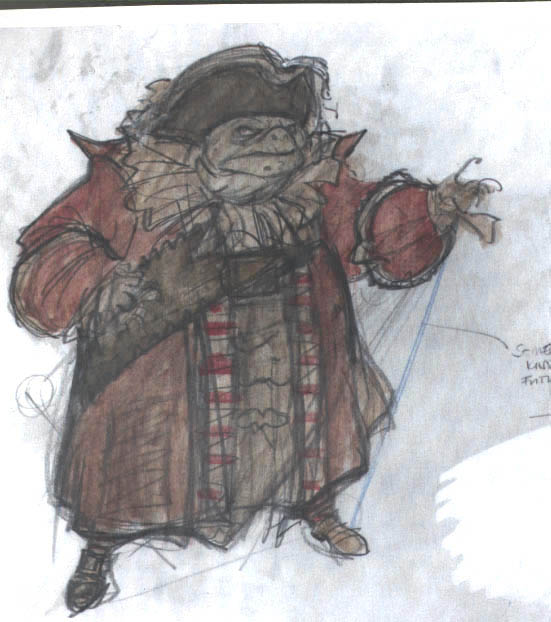 |
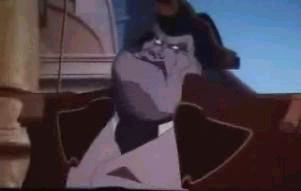 |
 |
INTERVIEW
WITH JOHN MUSKER AND ERIC DANIELS
Conducted by CHUD
at the August 2002 San Diego International Comic Con Festival with Director
John Musker & Lead Animator Eric Daniels.
Q: A book like "Treasure Island" has been around for a hundred years
and though it's always been seen as a real inspiring adventure tale for
kids, how do you adapt that to today's audiences and make it feel current?
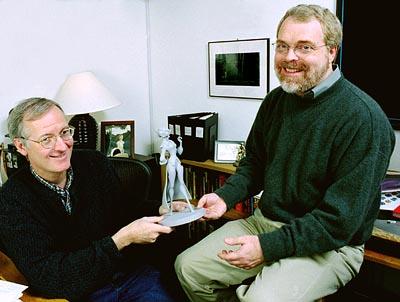
John: Well, I think when Ron first suggested this a long time
ago in 1985, he always wanted to see Disney do some kind of science fiction
story and he knew Treasure Island from when he was a kid. I think
we had tried, in adapting it, to keep to the heart of the story which is
still a boys coming-of-age story, a classic adventure story and a very
cliffhanger-y story. You end a chapter and something happens that
makes you want to go on to the next. We wanted to keep the archetypal,
iconic elements, so there are some of the equivalent scenes that there
are in the novel. There's sort of a discovery of the mutiny.
There's a negotiation scene between Jim and Silver that's not quite like
what's in the book, but almost like that. There's still the pursuit
of treasure. I think those archetypal elements still work today as
they did a long time ago. What we have changed are we did add elements
that push it a little bit more into action-adventure. For example,
Jim on his home planet is a bit of a hot-rodder. He's a borderline
juvenile delinquent. He's on the verge of going wrong and Silver
becomes a surrogate father to him. In the original tale, Silver was
kind of a surrogate father, but certainly Jim wasn't as dark as what we've
done to him. We've played him – his father abandoned him at an early
age. He's going to go the wrong way if somebody doesn't straighten
him up and ironically, it's a pirate that straightens him out. We
have do have things where Jim is doing this extreme sport called solar
surfing. It's kind of wind surfing, snowboarding, whatever that's
kinetic and visceral and just kind of fun to watch. With the technology
we have, this sort of "deep canvas plus" with the virtual effects, we can
move the camera around on a z-axis as well as an x and y, so we're able
to do a lot of moving camera things. So, I think it makes it more
contemporary than just playing out on a flat screen. Beyond that,
I think we just used our own sensibilities. We're boomer guys and
we came up as science fiction fans so we just tried to use elements of
science fiction that appeal to us. There are portals that open into
other worlds and these sort of sci-fi trappings that are on top of the
tale that I think bring kids that are more into Star Wars and Star Trek
and videogames – I think they have an entree into this that they wouldn't
have had if we did it strictly set in the 18th century or something like
that. It's made it more accessible. We'll see if it did or
not, but we feel like it did.
Q: Animated space movies have sometimes had a hard time connecting with audiences, like with Titan A.E. – how're you avoiding that?
John: Yeah, that's the question. We saw Titan A.E. and I do think one of the things that we were trying to do with this particular film is you can't rely on the scifi-ness to involve you. It's got to involve you emotionally, so we tried to make the story emotionally involving – Jim's rite-of-passage – so that you really get involved with him and the relationships of the characters which is a hallmark of Disney films that does go back to Snow White and whatever that you really care about the characters. You want to see what happens to them and you participate in the film that way. So, I think Titan A.E., which I saw and I thought the CG stuff in that was cool, but I didn't feel it worked that well in terms of the emotion of the story. They sold it completely as science fiction with rock and roll-stuff behind it and the story of the characters, I felt, didn't really involve you very much, so we still hold true to something that you get involved with. I think that's the most basic thing – and not relying on the "technique." Even though there are all these great techniques and the combination of 2-D and 3-D, if the basic story doesn't involve you then I think we're kind of dead. So, we hope we made a film that will engage you with characters and story. Like the classic Disney films are, like the Pixar films are, they really pull you in. It isn't just a matter of technique, but it really is the stories.
Q: Will you talk a little about how Disney is one of the last hold-outs
still working forward with traditional hand-drawn animation?
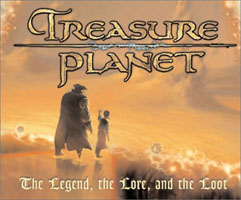
John: It's slightly ironic in the sense that it did start at
Disney, but then with the success of Lion
King and other things then a lot of other studios tried to get
in like Fox and Jeffrey over at Dreamworks has done 2-D films. There's
certainly a legacy at Disney of great two-dimensional animated films.
This film, ironically, is a fusion of 2-D and 3-D. We have 3-D characters
mixed with 2-D characters. We have Silver who has both elements.
We have environments that are 2-D, we have environments that are 3-D.
When we started on this film, I thought it was an interesting fusion. I
didn't quite see the whole CG-replacing-2-D thing coming. There was
some pressure on us from executives early on. They asked us, because
Dinosaur was wrapping up and that studio was going to fold and they said,
"how about doing Treasure Planet completely in 3-D?" At that time
at least, we didn't want to and I'm glad we didn't, but we felt there was
a very organic quality to 2-D animation in terms of expressiveness and
human characters that CG is still having a tough time with, though it's
getting better and better, but that's not necessarily what they do best.
With this film, we really wanted to do it in 2-D and I really hope that
2-D films continue to get made and I think Lilo & Stitch just worked
so much better than if they had done that in CG. I felt there was
such a charm to those characters, the water colors, and all that and I
think it's an artform like there's sculpture and drawing. Some people
say it's like sound versus silent films. I hope it's not like that,
but some of this is driven by the public. The trick is, the executives'
"reading" of the public's desire, so if they feel they can only be successful
with CG, then it's a self-fulfilling prophecy. However, again, I
saw Final Fantasy and again, I fell asleep in it. I liked
it, but it was a little soporific. It was kind of hypnotic and amazing
and yet, no story. So, the technique, after the first ten minutes
–just like in a hand-drawn film – the technique falls away and you've got
to rely on other things, which I think can only sustain it for so long.
I think 3-D films are going to go through a phase. I think a lot
of studios will get on the bandwagon and there are going to be some bad
ones out there. Who can say? I really don't know.
Q: So, it was a conscious decision to go ahead and blend 2-D and 3-D in Treasure Planet...?
John: In a way, it was ironic because Glen
Keane, who does the Silver character and Eric (Daniels), I think they
were drawn to the idea of a fusion and we did say, at times, like Glen
would say, there's his human side, his softer side – but then there's this
mechanical, CG side – the evil side! The evils of CG! But actually,
it wasn't like that though his human side, his 2-D side wins out and defeats
the evil 3-D side. We just saw this as an opportunity to stretch
the boundaries. On every movie we've worked on, we've always liked
to technical challenges. When we worked on Hercules
and we did the Hydra character, it was the first time in a Disney movie
that had a CG character interact with others and when we did The
Great Mouse Detective, the gears in that were all done in CG.
We've always looked for something that would be fresh for the audience.
I think we saw this in a way that would really help tell the story.
In Ron's earliest treatments, he really saw Silver as a cyborg and it just
seemed like a natural thing to do a cyborg using CG techniques. In
his earliest treatments, again, he had a robot and to do a robot in 2-D
wouldn't be exploiting the great things that CG does. So, we tried
to exploit both CGI and 2-D and fuse them. When we first pitched
it, it never got far enough to say one way or the other, but for the past
five years we definitely saw a heavy CG-thing.
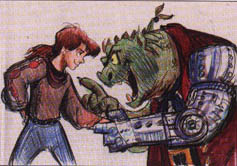 |
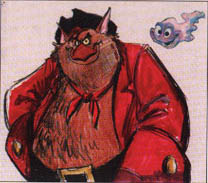 |
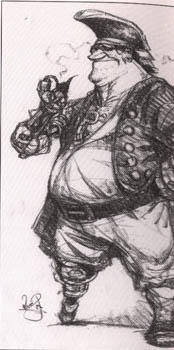 |
Q: Will you talk about the development of the Silver character, specifically in reference to early on when it might have gone CG or 2-D and what led to the fusion of both? Also, could you talk about some of the clockwork gadgets he has in his mechanical arm?
Eric: Glen and I had a bit of a tall order in designing his arm. Glen was in the process of designing the character while I was working on the various mechanical linkages that could be used for an elbow or something. Glen had a real, overall sense of what he wanted the character to be like massive-wise. He was sure, early on, that he wanted a big shoulder, a small bicep, and a large forearm and he had that in his mind as a good collection for good silhouette value. Specifics of what it was going to look like were up in the air. There was some talk that the arm should be simple enough so that if we had to do it in 2-D, if we couldn't produce the footage in 3-D that was necessary, that it could be drawn. My feeling on that was that if it could be drawn, it was not really taking advantage of what the computer could do. My impression of what it should look like was a lot of negative space, a lot of open holes where you could see through – it wasn't like it was just a costume thing. Gears and pulleys – so that any time a finger moved, I wanted to see gears and pulleys weighted back in the forearm that were manipulating it. I wanted it to all be believable and like if you actually went to a machine shop and made these pieces, you'd get an articulated arm. So, I had to figure out what kind of universal joint to put in the wrist – it's a very complicated process, but I was also running up against the obstacle that it had to look good and Glen constantly saying, "that's too wimpy, how about something like this!?" He'd grab a crayon and draw something massive and I'd go, "oh, well, I guess it does look better." So, I worked at the design and then I'd show him how the elbow would work and he'd say, "ah, that one would work because it's got good silhouette value."
John: It was your idea, was it not, in terms of – we didn't want it to be magic, we wanted it to have a believability to it, so it wasn't just like Inspector Gadget where we'd suddenly do a Tex Avery thing out of his arm, so I believe it was Eric that came up with the whole idea of the magazines that turn and move off...
Eric: Right. It's based on, well, my uncle had a hotel in Wyoming that I used to visit every summer and in the lobby of this hotel he had a jukebox. I used to be fascinating by the jukebox mechanism. Records would go around and rotate on this axis (indicates with his hand) until one was selected and then something would take one of the records and rotate it on a different axis and put it on a playing platter. So, I realized that since Glen wanted a big massive forearm, I could use that to my advantage. I could have a rotating turntable like cartridges in a gun. They'd rotate around this way until one was lined up with the hand and then it would rotate this way, the hand would fold in and the object would come out. In that way, we could always rotate a new tool in place. Technically, there's only three slots in the arm and he has like fifty tools (laughs)
John: There's a little bit of magic in it, but not much.
Q: Was there ever a maquette of this?
Eric: It was a whole lot of drawings Glen and I did back and forth. Steven Olds actually I have to mention his involvement – he did so many incredible, mind-blowing drawings of what the arm could look like. Glen and I worked off of those drawings and narrowed it down to one particular set of shapes that we liked and we gave that to Steven Olds and he worked it over and gave it the feel of the film.
John: Actually, the maquette was built using the computer files that Eric generated. So, we got the maquette fairly late in the process because it was being refined. So, the human part of Silver was sculpted by Kent Melton whose done all these great sculptures for all the characters. The CG part was actually imported by the files to make these. When I went into Eric's room it was like seeing a model airplane laid out or like a dentist's office where you had all the tools out on the tray. So, they were fine-tuning a lot of that as it was being put together.
Eric: I have great respect for the designers of Revell model
kits now. I had no idea how hard it would be to make something that
could actually be built. I thought I was designing something that
could actually be built. It turns out that there were some things
that I'd cheated on unknowingly, there were certain things that would actually
have to be disassembled in this particular way though we had built it in
a different way. There was all kinds of learning going on just trying
to get this thing into the form of a useful maquette.
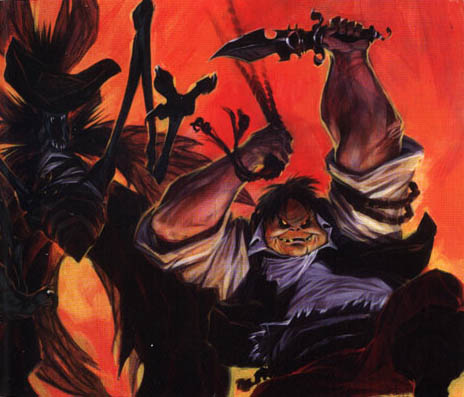
John: And they further complicated things because we never knew
how much of Silver would be CG and I think Glen came up with this idea
that he could have this headpiece, based on a locomotive thing that's always
cranking and turning in CG and the production people were like, "wait,
wait, wait! You can only do the arm!" Eric did a great job
of locking it to the head and it gave it a really cool feel. Silver
has this eye that has these phalanges and can turn into this telescopic
thing. It's just kind of cool the way to do it.
Eric: There are two ways to open that eyeball. You can bring the eyelids back like a normal eyeball, but also the "scary" opening mode also where each eyelids is divided into three pieces and it would open up like the petals of a flower – a shocking, suddenly startling look. We used that mainly when he's angry.
John: He has sort of a mood-colored eye. As he gets angry, it gets redder, but then goes back to gold. It turns white when he's really on the trail of the treasure, I think.
Eric: We also did a subtle thing with the wheels turning in his head. The thought that Glen and I had was, does it pump hydraulic fluid around? It's sort of like the mechanical heart of the character, so when he's really excited or especially angry, we sped that thing up just a little bit.
John: The wheels are literally turning.
Q: You mentioned on the panel that the "lifting off" sequence took
around a year and a half to do. What are some of the other big set
pieces in the movie that took quite some time to animate?
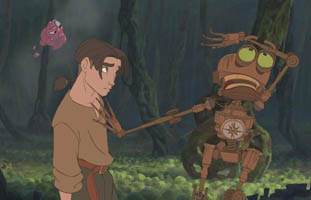
John: Well, one of the big set pieces is the mutiny where basically
Silver is discovered by Jim that he's really a pirate and it's a parallel
scene with one in the novel. That's when Silver blows his whistle.
Is the whistle still a part of his head? I don't remember.
Eric: We ended up not doing that.
John: Anyway, the pirates storm the ship, Jim has to escape,
there's a big chase through the ship. There's a longboat bay where
the two boats are and there's a pitch battle between the pirates, so there's
a big action-adventure set piece that's really cool that has a lot of neat
cutting and what-not. There's a sequence where Jim has to go back
to the ship a'la the movie and the novel where he's supposed to retrieve
the map - he's accidentally left it on the ship – only to discover when
he gets back there that Scroop, this big insectoid guy is there on the
ship standing guard and basically it's a bit like Alien. He's chased
through this darkened ship by this big spider, down these dark corridors,
through all these overhanging cables and the power's out and the gravity.
Ben's trying to unplug the laser cannons, trying to help him out, but he
winds up unplugging the gravity so there are several weightless battles
between him and Scroop. So, there's that sort of set piece.
(S.J.R. Note: Musker told me another HUGE set piece, but it's the climax
of the film, so I didn't want to give it away here) The opening
of the film is sort of our homage to pirate films, so this is Captain Flint's
pirate ship storming a merchant vessel and we see all these cool aliens
going over the rail and having at. It's our homage to the Errol Flynn
movies.
|
||||||||||||